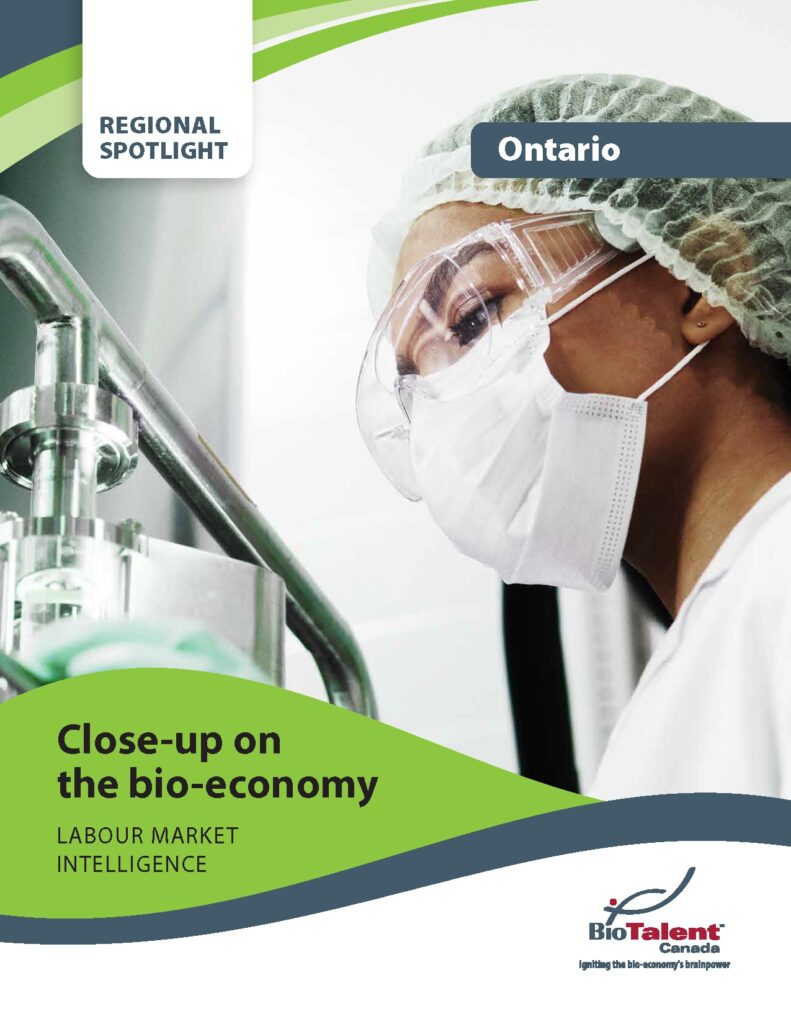- Place an order, or for other inquiries:
- 416-923-3567 ext. 3325
- content@newsmediacanada.ca
New Report Predicts Plenty of Opportunity, Not Enough Workers, for Ontario’s Bio-Economy
Labour market study underscores gaps exposed by COVID-19 pandemic
OTTAWA, ON –/COMMUNITYWIRE/– The bio-economy, a vital sector of the Ontario economy, is poised to create jobs, but the current pipeline for those positions is three-quarters empty.
This was the conclusion of an unprecedented labour market study by BioTalent Canada released this fall. Today, the organization released eight reports that unpack the current landscape, trends, challenges, and opportunities facing each region.
The report on Ontario — and an accompanying report on the Greater Toronto Area — conclude the region will require another 24,500 bio-economy workers by 2029. However, current estimates indicate there will not be enough people to meet labour demands, and significant pressure exists now and will mount throughout the decade. Ontario companies will be challenged to fill positions due in part to a highly competitive labour market and an ongoing lack of capital to attract and retain candidates.
The reports note that the COVID-19 pandemic exposed significant gaps in the Canadian bio-economy, particularly in bio-manufacturing and processing capacity, which saw Canada initially unable to produce sufficient protective equipment and having no domestic capacity to develop and manufacture vaccines. Efforts to close this gap could be hampered by a lack of qualified labour, especially in a province like Ontario seeking to expand its manufacturing sector.
Estimates suggest Ontario will need an additional 5,820 bio-manufacturing workers by 2029 (2,170 in bio-health manufacturing alone) even without considering expansion growth due to recently announced investments. Only 25% of those positions will be fillable by predicted supply during this period.
“Naturally, as the country’s largest region, the talent need is greatest in Ontario,” says BioTalent President and CEO Rob Henderson. “The industry has to develop new strategies focused on breaking down barriers to entry for recent immigrants, Indigenous workers and workers with disabilities — all of whom are seriously under-represented in the bio-economy today. That starts with improving human resources capacity and practices within bio-economy companies.”
Other notable findings in the Ontario regional analysis:
- Ontario accounts for 36% of Canada’s bio-economy, with 4,100 organizations – mainly small and medium-sized businesses – collectively employing about 75,000 people in 2019.
- The Ontario bio-economy workforce covers a wide range of occupations, with research & development and manufacturing accounting for nearly half of all jobs.
- Following expansion in 2020 and a slight downturn in 2021, employment in the Ontario bio-economy is expected to grow by 1.3% annually in the short term and 1.1% over the medium/longer term.
- Ontario is home to a high proportion of Canada’s post-secondary programs related to the bio-economy. In 2016-2017, more than one-third of Canada’s master’s and doctorate students and nearly half of undergraduate students in bio-economy related programs were enrolled in Ontario institutions.
SUB-REGIONAL TRENDS
Sub-regional differences in economic conditions impact on bio-economy activity in those areas of the province. Some of the more notable trends in sub-regions of Ontario:
Northern Ontario
- Largely focused on sustainable development, specifically forestry.
- Recruitment challenges include fewer tradespeople available due to migration, competition with the mining industry and a lack of infrastructure for long-term career progression in the area.
- Participation in the Rural and Northern Immigration Pilot and First Nations-focused skills training initiatives may help mitigate some of these issues.
Greater Toronto Area
- Home to a mix of large companies and smaller start-ups, mostly in bio-health, with a strong focus on pharmaceuticals.
- Start-ups often hire directly from post-secondary institutions, but retention can be a challenge because larger companies can offer better salaries.
- Mid-level management roles are difficult for most companies to fill because start-ups are often bought out by larger firms before their management teams have a chance to gain experience.
Southwestern Ontario
- Home to a bio-industrial hub that relies heavily on technicians.
- Local colleges supply much of the required labour, and students who study elsewhere often return to this area.
- The bio-industrial sub-sector experiences significant volatility, which can make it difficult to fill expansion demand after a period of contraction.
Southern Ontario
- Focused primarily on agri-bio.
- Proximity of the GTA presents both advantages and challenges for recruitment and retention.
Eastern Ontario
- Grounded in bio-health, particularly R&D associated with government research facilities and the Ottawa Hospital Network.
- Ottawa’s high-tech industry also supports a secondary focus on digital health tools.
- The area’s multiple post-secondary institutions make it easy to hire for entry-level positions, but more senior talent tends to leave the area for larger, more lucrative markets.
For additional information and to read the full reports, visit: biotalent.ca/lmistudy.
Funded in part by the Government of Canada’s Sectoral Initiatives Program.
About BioTalent Canada
BioTalent Canada supports the people behind life-changing science. Trusted as the go-to source for labour market intelligence, BioTalent Canada guides bio-economy stakeholders with evidence-based data and industry-driven standards. BioTalent Canada is focused on igniting the industry’s brainpower bridging the gap between job-ready talent and employers and ensuring the long-term agility, resiliency, and sustainability of one of Canada’s most vital sectors. Recently named one of the 50 Best Workplaces in Canada with 10-50 employees and certified as a Great Place to Work® for 2021, BioTalent Canada practices the same industry standards it recommends to its stakeholders. These distinctions were awarded to BioTalent Canada following a thorough and independent survey analysis conducted by Great Place to Work®.
For more information, please visit biotalent.ca.
Contacts
Media Inquiries
Siobhan Williams
Director, Marketing and Communications
BioTalent Canada
613-235-1402 ext. 229
swilliams@biotalent.ca
Rob Henderson is available for comment.




